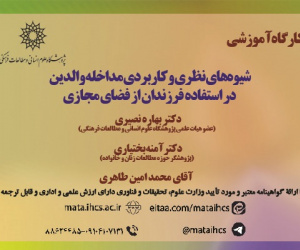بررسی تاثیر ارکان تعالیم طریقت صفویه بر مناسک تعزیه حسینی در اردبیل با تاکید بر لزوم حفظ نظم تاریخی تعزیه (مقاله علمی وزارت علوم)
درجه علمی: نشریه علمی (وزارت علوم)
آرشیو
چکیده
هدف اصلی تحقیق بررسی نحوه تاثیر تعالیم طریقت صفویه (اندیشه های شیخ صفی الدین ابواسحق اردبیلی) درتعزیه های حسینی میراث دوران صفویه می باشد. در این تحقیق با بررسی دو نمود اصلی آئین تعزیه اردبیل، «طشت گذاری» و «شمع گردانی» و نحوه اختتام آن مراسم، مفهوم و معنای همراهی دو مقوله «طریقت» و «شریعت»_ را که بن مایه اصلی اندیشه شیخ صفی الدین اردبیلی در رسیدن به «حقیقت» می باشد_ در مراسم تعزیه یادگار دوران صفویه به وضوح مورد مداقه قرار می گیرد. در بررسی نحوه ظهور تعالیم طریقت صفویه در تعزیه، با بهره گیری از نظریات «گیرتز» و « مرتون» به موضوع حفظ نظم تاریخی تعزیه در جلوگیری از ظهور «مناسک گرایی» پرداخته می شود. روش پژوهش اسنادی و کتابخانه ای می باشد. نتایج تحقیق نشان می دهد علاوه بر نقش نخبگان دینی در حفظ و نشر محتوای اصلی گفتمان عاشورای حسینی، حفظ نظم تاریخی تعزیه خود می تواند منجر به حفظ معارف اصلی دینی و بازتولید دال مرکزی آن گفتمان گردد و هرگونه تغییر مبدعانه غیرتاریخی در ظاهر مناسک می تواند تبعات جبران ناپذیر شناختی در امر دینی به بار آورد.Investigating the influence of the teachings of the Safavid Tariqa on Hosseini's Ta'zieh rites in Ardabil Emphasizing the need to preserve the historical order of Ta’zieh
The main purpose of the research is to investigate the influence of the teachings of the Safavid method (thoughts of Sheikh Safidin Abu Ishaq Ardabili) in Hosseini's restoration of the legacy of the Safavid era. In this research, by examining the two main manifestations of Ardebil Ta'ziyya ritual, "Tashtghozari" and "shamgardani" and the manner of concluding the ceremony, the two categories of "method" and "Sharia" which are the main idea of Sheikh Safi al-Din Ardabili. Be that as it may, it is clearly highlighted in the memorial ceremony of the Safavid era. In the study of how the teachings of the Safavid method appeared in Ta'ziyya, using the theories of "Geertz" and "Merton", the issue of preserving the historical order of Ta'ziyya is discussed in order to prevent the emergence of "ritualism". The research method is documentary and library.The results of the research show that in addition to the role of religious elites in preserving and publishing the main content of Ashura Hosseini's discourse, maintaining the historical order of Ta'zih itself can lead to the preservation of the main religious teachings and the reproduction of the central sign of that discourse, and any creative non-historical change in the appearance of rituals can It brought irreparable cognitive consequences in religious matters. Introduction Every religious event in the society has reflections that crystallize in different dimensions. Rituals, as the external manifestation of religious events, sometimes change over time and sometimes become colorful. Dealing with mourning rituals, which is an important and even main aspect of a religious event; It can provide information on the interaction of the main actors and its influence on social and political currents. A set of ancient and traditional rituals, which often have historical, cultural and religious roots, have emerged according to the requirements of the time and the basic spiritual needs of human beings, and they carry important epistemological and cognitive meanings that the durability and survival of those rituals in the history of human life for decades The long ones confirm that they are functional. In addition to primary rituals, there are secondary rituals which were not part of the main rituals of religion at first, but they were formed according to certain socio-historical conditions, they have expanded in the historical life of believers and sometimes they have more priority and importance in the system of rituals. They have found religion. This finding of priority is due to the role and function they have for religious people; Therefore, understanding the position of secondary rituals, its position in the ritual system of religion and why this position and its consequences are of particular importance. Muharram mourning ceremony is the most important example of these rituals. Within this system, there is a certain hierarchy between different rituals, which is affected by two factors: first, the situation and relationship between the primary rituals and secondary rituals, and second, the social, cultural, livelihood and political conditions of believers. Based on this, understanding this hierarchy and the place of a ritual in this system and the religious discourse about it is very important in understanding and understanding the religion and religiosity of believers in their specific historical and social context. Nowadays, due to various political and social factors, the forms of ancient and historical rituals undergo changes that can prevent those rituals from reproducing the original teachings. A case study of Ta’zieh rituals of the Safavid heritage shows that these rituals have preserved the concept of "combination of the two categories of Safavid method and sharia" and in it, only the external aspects of the rituals have not been emphasized and strengthened. Because stopping in the tangible matter will take the opportunity to pay attention to human values and basic knowledge; In











